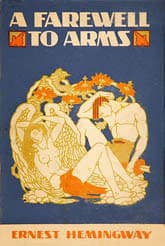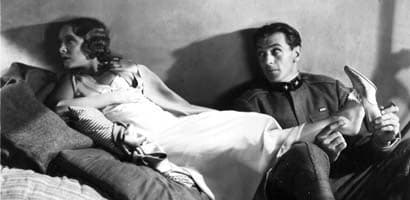A Farewell to Arms
Critique • Quotes • At the movies
 First edition, 1929
First edition, 1929First publication
1929
Literature form
Novel
Genres
Literary
Writing language
English
Author's country
United States
Length
Approx. 101,000 words

Wounded Frederick Henry (Gary Cooper) finds love with nurse Catherine Barkley (Helen Hayes.
Is that any way to say goodbye?
A Farewell to Arms (1932): Film, 88 minutes; director Frank Borzage; writers Benjamin Glazer, Oliver H.P. Garrett; featuring Gary Cooper, Helen Hayes, Adolphe Menjou
You might think Ernest Hemingway's writing would be easily adapted for movie-making—plenty of action, terse dialogue, not a lot of psychological stream of consciousness....
But much of Hemingway's greatness is how he puts words together, his stylistic understatement. In the opening of his World War I novel, A Farewell to Arms, he presents the spectacle of the armies moving back and forth through the landscape and the villages, powdering the trees with their dust. The rhythms of his rolling sentences with their repetitive simple terms creates an incredibly evocative passage, setting a world-weary tone for all that is to follow in the lives of two young lovers caught up in the war.
In a film though, you can only show pictures of armies marching, bombs exploding, and lovers embracing. Not the same thing.
Brief farewell
Hemingway's novel is quite worldly, very adult for its time, in its clear-eyed depiction of both war and love. It's not surprising however that films would take a more sentimental approach.
The 1932 film of A Farewell to Arms with Gary Cooper as the ambulance driver Frederick Henry, an American in the Italian army, and Helen Hayes as the nurse Catherine Barkley, does provide some mature content, implying sex between the unmarried couple (although they are excused by an informal marriage service carried out by a sympathetic priest), resulting in a pregnancy. The couple are separated with her running off to Switzerland to have the baby and him deserting to look for her—at the risk of his life. A teary ending. And that's about it.
The hour and a half of film time doesn't allow for more than a few montages of actual warfare. It cuts out the couple's entire stay in Switzerland. And it replaces the masterful, lonely finale of the novel with a corny scene of Coops bearing his lover's dead body to a sun-streaming window, crying out "Peace! Peace!" as bells peal out news of the armistice.
Trailer for the first film adaptation of Hemingway's A Farewell to Arms.
If we forget the novel though (usually a wise move) and just look at the film as a romantic epic of Hollywood's bad old days, this adaptation does have quite a few merits. Innovative camera work. Moody lighting. Adolphe Menjou as Rinaldi, the Italian doctor who is both a fun-loving buddy and rival to Lieutenant Henry.
I suspect the film was shot almost entirely in studios, as films usually were in those days, but the settings are convincing. And despite the leads' sometimes awkward difference in size—Hayes in heels doesn't come up to Cooper's shoulders—they are appealing together. The camera loves them both.
On the other hand, the production is quite dated. This is an early talkie and it is often reminiscent of the just-past era, helmed as it is by silent-film director Frank Borzage. Exaggerated facial gestures. Slow moments when actors seem to be standing around waiting for others to finish their lines. The first half of the film is hollow-sounding, bereft of background music or incidental sound effects.
Worse, the script takes for granted we understand why the characters act as they do in certain scenes, when the motivations completely elude me. I'm not even sure what the soldier Henry and the nurse Barkley see in each other. It's as though there's an unwritten rule that when handsome guy and dishy girl are in the same movie together, after a certain point it's understood they are deeply in love.
Who'd you expect to win the gal in this American flick—Adolphe Menjou?
— Eric
Critique • Quotes • At the movies
1932, 1957

